Scotland's carbon footprint: 1998 - 2017
Estimates of Scotland's greenhouse gas emissions on a consumption basis.
Breakdown of Scotland's Carbon Footprint, 1998-2017
Table 1 outlines how the Carbon Footprint has been categorised for this publication.
Table 1. Categorisation of Scotland's Carbon Footprint
| Main Category | Activity | Description |
|---|---|---|
| Greenhouse Gas Emissions from UK Produced Goods and Services | Scottish consumption of UK production | UK production emissions attributable to Scottish final consumption, including manufacturing and transport, international aviation and shipping provided by Scottish operators. |
Greenhouse Gas Emissions Embedded in Imported Goods and Services – By Region of Import
|
Imports used by UK businesses for Scottish consumption | Greenhouse Gas Emissions associated with the production of imports which are used by UK industry and attributable to Scottish final consumption |
| Imports directly used by Scottish consumers | Greenhouse Gas Emissions associated with the production of imports which are used by Scottish final consumers | |
| Greenhouse Gas Emissions Directly Produced By Scottish Residents | Private motoring | Greenhouse Gas Emissions generated directly by households through private motoring. |
| Household heating | Greenhouse Gas Emissions arising from households' use of fossil fuels for heating, households use of aerosols, etc. |
Chart 2 shows Scotland's carbon footprint, broken down into three main components, from 1998 to 2017.
- Greenhouse gas emissions embedded in imported goods and services from overseas. These accounted for 53.3 per cent of Scotland's carbon footprint in 2017; up from 42.6 per cent in 1998.
- Greenhouse gas emissions embedded in UK produced goods and services. These accounted for 28.9 per cent of Scotland's carbon footprint in 2017; down from 42.5 per cent in 1998.
- Greenhouse gas emissions directly produced by Scottish residents. These account for 17.8 per cent of Scotland's carbon footprint in 2017; from 15.0 per cent of total consumption-based emissions in 1998.
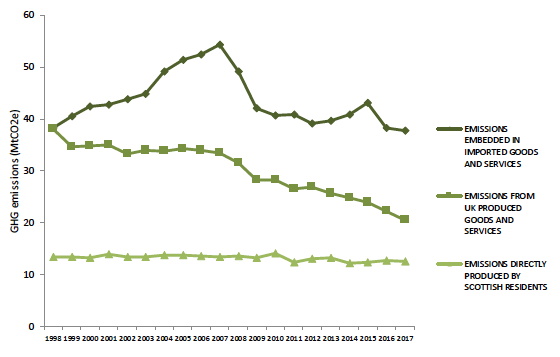
Additionally, Chart 2 shows that:
- Greenhouse gas emissions associated with imported goods and services increased from 38.1 MtCO2e in 1998 to their peak of 54.2 MtCO2e in 2007 (an increase of 42.2 per cent over this time period). These emissions accounted for 53.6 per cent of Scotland's carbon footprint in 2007.
- Between 2007 and 2017, greenhouse gas emissions embedded in imported goods and services fell by 30.5 per cent; this compares with a 1.1 per cent decrease in emissions embedded in imports over the whole time period from 1998 to 2017.
- Greenhouse gas emissions relating to the consumption of UK produced goods and services by Scottish residents fell from 38.0 MtCO2e in 1998 to 20.4 MtCO2e in 2017 – a fall of 46.3 per cent. There was a year-on-year fall in greenhouse gas emissions from this category over the majority of years in the time period.
- Greenhouse gas emissions generated directly by Scottish residents have fallen from 13.4 MtCO2e in 1998 to 12.6 MtCO2e in 2017 – a fall of 6.0 per cent over this time period.
Chart 3 shows how Scotland's carbon footprint fell by 18.9 MtCO2e (21.1 per cent) between 1998 and 2017.
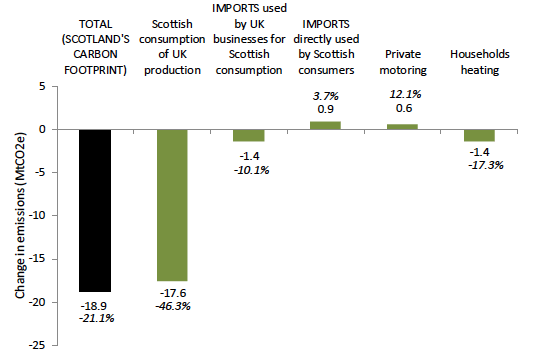
Chart 3 shows that between 1998 and 2017:
- Greenhouse gas emissions from Scottish consumption of UK production have seen the greatest absolute reduction over this time period (17.6 MtCO2e; a 46.3 per cent reduction), reflecting the emissions-reduction seen in the Scotland and the rest of the UK over this period.
- Greenhouse gas emissions embedded in imports directly used by Scottish consumers have increased by 0.9 MtCO2e (a 3.7 per cent increase).
- Emissions embedded in imports used by UK businesses for Scottish consumption have decreased by 1.4 MtCO2e (a 10.1 per cent decrease).
- Greenhouse gas emissions resulting from households heating have decreased by 1.4 MtCO2e (a 17.3 per cent decrease) whilst private motoring emissions have increased by 0.6 MtCO2e (a 12.1 per cent increase).
Chart 4 shows how Scotland's carbon footprint has changed from 2007 to 2017. The year 2007 has been chosen as the base year for this chart as it represents the peak value in the series. Scotland's carbon footprint has fallen by 30.4 MtCO2e (30.0 per cent) over this time period.
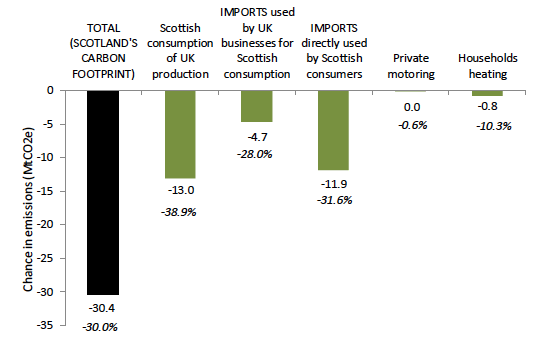
Chart 4 also shows that between 2007 and 2017:
- Greenhouse gas emissions embedded in Scottish consumption of UK production fell by the greatest amount, both in absolute and percentage terms (a reduction of 13.0 MtCO2e; 38.9 per cent).
- There were also considerable reductions in greenhouse gas emissions attributed to imports directly used by Scottish consumers (11.9 MtCO2e; 31.6 per cent).
- Emissions embedded in imports used by UK businesses for Scottish consumption decreased by 4.7 MtCO2e (a fall of 28.0 per cent).
- Greenhouse gas emissions attributed to private motoring and household heating have seen smaller reductions (0.6 per cent for private motoring; 10.3 per cent for households heating).
Chart 5 shows that Scotland's carbon footprint has fallen by 2.5 MtCO2e (3.5 per cent) in the latest year.
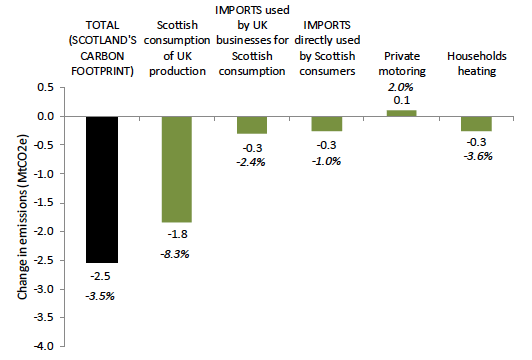
Chart 5 also shows that between 2016 and 2017:
- Emissions embodied in Scottish consumption of UK production fell by 1.8 MtCO2e (8.3 per cent).
- Embedded emissions in imports directly consumed in Scotland fell by 0.3 MtCO2e (1.0 per cent).
- Emissions embedded in imports used by UK businesses for Scottish consumption also decreased by 0.3 MtCO2e (a fall of 2.4 per cent).
- There was a relatively minor increase in the level of absolute emissions in private motoring (0.1 MtCO2e), and a modest reduction in household heating emissions (0.3 MtCO2e).
Chart 6 presents a breakdown of Scotland's embedded greenhouse gases by region of import.
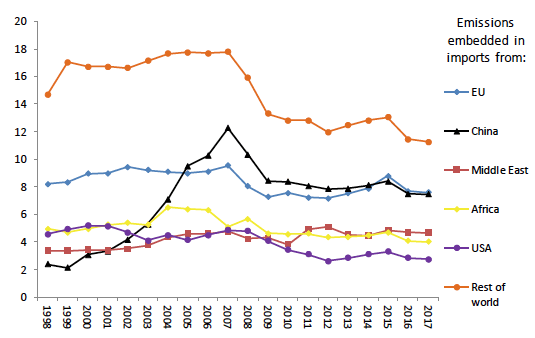
- Over half of all greenhouse gas emissions embedded in imported goods and services originate from areas other than the EU and China. This trend is consistent throughout the entire time series. Greenhouse gas emissions associated with these "rest of world" imports increased from 28.8. MtCO2e in 1998 to a peak of 34.9 MtCO2e in 2006 (a 21.1. per cent increase). They then fell steadily to 28.8 MtCO2e in 2012. Following 2012, these embodied emissions have been increasing slowly, before falling to 24.8 MtCO2e in 2016, and to a record low of 24.4 MtCO2e in 2017.
- Greenhouse gas emissions embedded in EU imports increased from 8.2 MtCO2e in 1998 to 9.5 MtCO2e in 2007 before falling to their lowest point of 7.1 MtCO2e in 2012. Over the entire time-series, these embodied emissions show a decrease of 7.4 per cent from 1998 to 2017.
- Greenhouse gas emissions embedded from imports to Scotland from China have increased substantially, from 2.4 MtCO2e in 1998 to 12.3 MtCO2e in 2007. Emissions embedded in these imports fell for 5 consecutive years following the 2007 peak and remained relatively stable until 2016 where they fell to 7.5 MtCO2e and they remain at that level in the latest year. Over the entire time-series, embodied emissions associated with imports from China have increased by more than double their amount in 1998.
Contact
Email: lisa.lochran@gov.scot
There is a problem
Thanks for your feedback